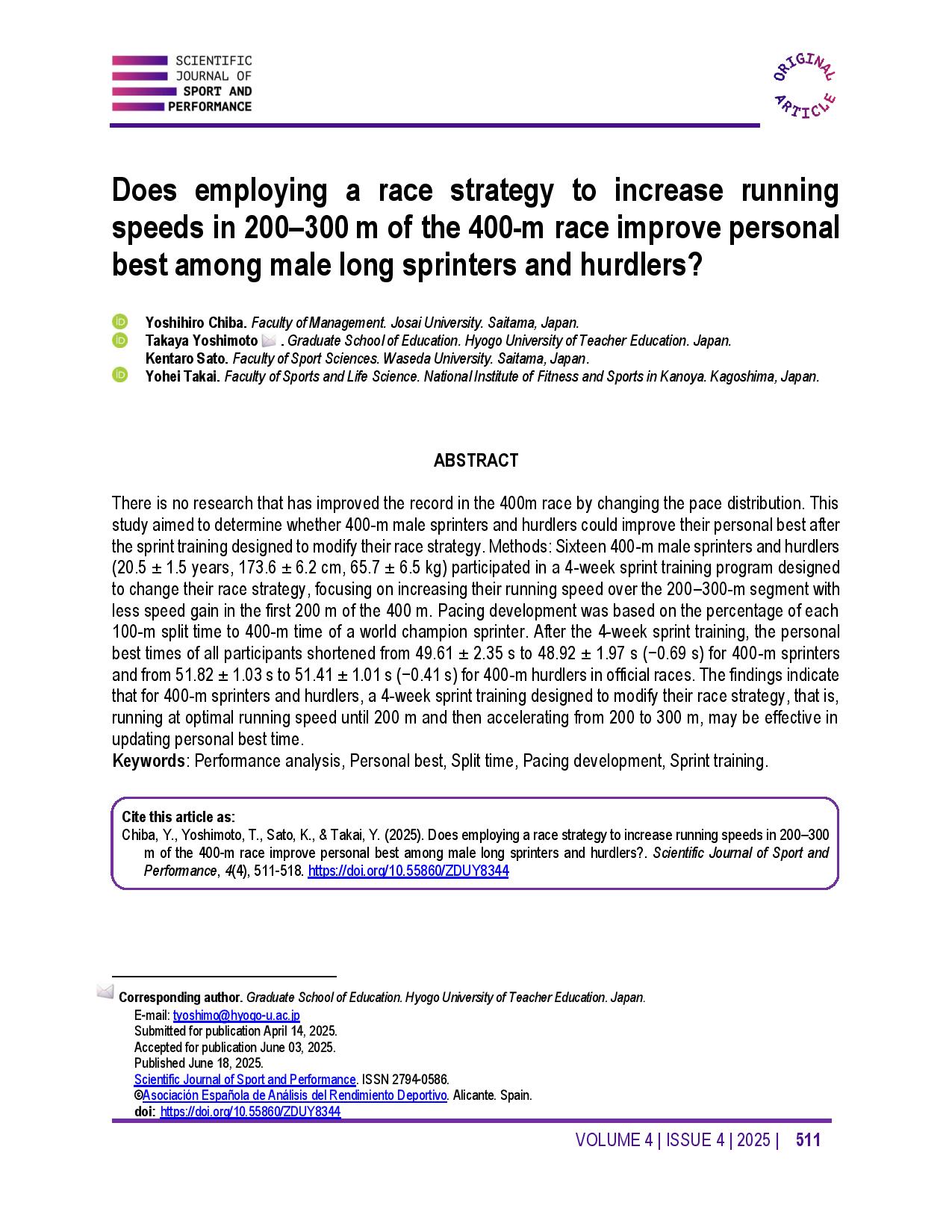Does employing a race strategy to increase running speeds in 200–300 m of the 400-m race improve personal best among male long sprinters and hurdlers?
Main Article Content
Abstract
There is no research that has improved the record in the 400m race by changing the pace distribution. This study aimed to determine whether 400-m male sprinters and hurdlers could improve their personal best after the sprint training designed to modify their race strategy. Methods: Sixteen 400-m male sprinters and hurdlers (20.5 ± 1.5 years, 173.6 ± 6.2 cm, 65.7 ± 6.5 kg) participated in a 4-week sprint training program designed to change their race strategy, focusing on increasing their running speed over the 200–300-m segment with less speed gain in the first 200 m of the 400 m. Pacing development was based on the percentage of each 100-m split time to 400-m time of a world champion sprinter. After the 4-week sprint training, the personal best times of all participants shortened from 49.61 ± 2.35 s to 48.92 ± 1.97 s (−0.69 s) for 400-m sprinters and from 51.82 ± 1.03 s to 51.41 ± 1.01 s (−0.41 s) for 400-m hurdlers in official races. The findings indicate that for 400-m sprinters and hurdlers, a 4-week sprint training designed to modify their race strategy, that is, running at optimal running speed until 200 m and then accelerating from 200 to 300 m, may be effective in updating personal best time.
Article Details

This work is licensed under a Creative Commons Attribution-NonCommercial-ShareAlike 4.0 International License.
Funding data
-
Japan Society for the Promotion of Science
Grant numbers 24K14445
References
Chiba, Y., Sato, K., Yoshimoto, T., Ohnuma, H., Yamanaka, R., Takahashi, K.,…Takai, Y. (2025). Revamping Pace Distribution: A Case Study on Elevating the Men's 400 m Track and Field Japanese National Record After 32 Years. Journal of Strength and Conditioning Research, 39(4), e610-e615. https://doi.org/10.55860/UDQX4879 DOI: https://doi.org/10.55860/UDQX4879
Coppenolle, H. (1980). Analysis of 200-metres intermediate times for 400-metres world-class runners. Track and Field Quarterly Review, 80(2), 37-39.
Duffield, R., Dawson, B., & Goodman, C. (2005). Energy system contribution to 400-metre and 800-metre track running. Journal of Sports Sciences, 23(3), 299-307. https://doi.org/10.1080/02640410410001730043 DOI: https://doi.org/10.1080/02640410410001730043
Gastin, P. B. (2001). Energy system interaction and relative contribution during maximal exercise. Sports Medicine, 31(10), 725-741. https://doi.org/10.2165/00007256-200131100-00003 DOI: https://doi.org/10.2165/00007256-200131100-00003
Hanon, C., & Gajer, B. (2009). Velocity and stride parameters of world-class 400-meter athletes compared with less experienced runners. Journal of Strength and Conditioning Research, 23(2), 524-531. https://doi.org/10.1519/JSC.0b013e318194e071 DOI: https://doi.org/10.1519/JSC.0b013e318194e071
Saraslanidis, P. J., Panoutsakopoulos, V., Tsalis, G. A., & Kyprianou, E. (2011). The effect of different first 200-m pacing strategies on blood lactate and biomechanical parameters of the 400-m sprint. European Journal of Applied Physiology, 111(8), 1579-1590. https://doi.org/10.1007/s00421-010-1772-4 DOI: https://doi.org/10.1007/s00421-010-1772-4
Sato, K., Yoshimoto, T., Ohunma, H., & Chiba, Y. (2023). Study of critical sprinting phase in 400-m sprint performance and race development characteristics of top sprinters in Japan. Japan of Sprint Research, 32, 15-24.
Schiffer, J. (2008). The 400 metres. New Studies in Athletics, 23(2), 7-13.
Stoyanov, H. (2016). Opportunities for breaking 43 seconds in the men's 400m. New Studies in Athletics, 31(1-2), 59-68.
Yoshimoto, T., Chiba, Y., Sato, K., Ohnuma, H., & Takai, Y. (2025). A study of men's 400m pacing strategy. Japan Society of Sprint Research, 33, 19-28.




